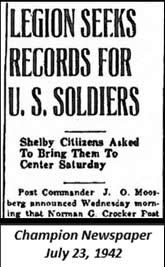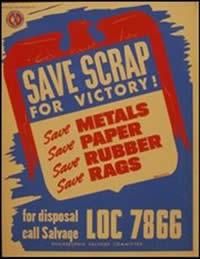
June 7, 2015 - As long as Johnny has been marching off to war there has been a “home front” in support. Wikipedia defines home front as an informal term for the civilian populace of the nation at war as an active support system of their military. Military Forces during World War II depended on home front civilian support services such as factories that build material to support the military front. There’s  the always popular “Rosie the Riveter” who freed up fighting men by working in the factories on the home front.
the always popular “Rosie the Riveter” who freed up fighting men by working in the factories on the home front.
Small communities like Shelby County, Texas didn’t have factories but the citizens did their part by conducting scrap drives and collecting metal, tires, etc. for these factories to use in building ships, airplanes and other equipment needed to fight the war.
 In July, 1942 a scrap drive that I had never heard of was held here by members of the Norman G. Crocker American Legion Post # 284. Post Commander J. O. Moosberg announced that the post was going all out on the collection of their share of 37 million used phonograph records that would be sold for scrap to make new records for the entertaining of the boys in our Army, Navy and Air Corps.
In July, 1942 a scrap drive that I had never heard of was held here by members of the Norman G. Crocker American Legion Post # 284. Post Commander J. O. Moosberg announced that the post was going all out on the collection of their share of 37 million used phonograph records that would be sold for scrap to make new records for the entertaining of the boys in our Army, Navy and Air Corps.
The National American Legion Headquarters was the sponsor of this effort and recording artists such as Kate Smith, Gene Autry and others agreed they would give of their time and talent in making new recordings from the funds raised by the selling of the 37 million old records. It was simple and anyone with a phonograph record in any condition could contribute. Cracked and chipped records were worth as much as a brand new one as they would all go into the same big melting pot.
 The Legion members suggested that when citizens came to Center on Saturday evening, July 25th, 1942 to get election returns from the bulletin board, they also bring all of their old, used, cracked or broken records. The post provided at the bulletin board on the square boxes and receptacles for the records. The article in the Champion Newspaper of July 23rd, 1942 ended by saying “let’s get them together and everyone do his small part is providing music for the boys in camp”.
The Legion members suggested that when citizens came to Center on Saturday evening, July 25th, 1942 to get election returns from the bulletin board, they also bring all of their old, used, cracked or broken records. The post provided at the bulletin board on the square boxes and receptacles for the records. The article in the Champion Newspaper of July 23rd, 1942 ended by saying “let’s get them together and everyone do his small part is providing music for the boys in camp”.
I’m not sure how it came out or how many records were collected that July evening in Shelby County but according to the Library of Congress website the entire effort across the country proved to be a success. The shellac from the records is what was recovered (recycled) as the supply in the US was very restricted. Four million pounds of the round discs were collected resulting in 300,000 new records that were distributed to servicemen. A second drive was held in May, 1943 and records piled up by the hundreds of millions.
As with all good intended ideas there can also be a downside not seen at the time. Karen Fishman along with Jan McKee who wrote the article “Scrap for Victory!” on the Library of Congress’ website said “The general belief, shared by both the recording industry and the audience, was that entertainment was ephemeral (short-lived) and didn’t need to be protected or preserved. Popular music was perceived to have no lasting value, and the recording companies never viewed it as important to save and archive sound recordings, master recordings and alternate takes. To most of the recording industry, warehousing yesterday’s popular records and the masters needed to press them was just one huge, expensive headache. World War II scrap drives were the perfect answer to the industry’s storage problems. Suddenly, emptying the archive turned into a patriotic duty”.
No one knows how many recordings were lost during these scrap drives and the greatest loss was the destruction of the metal masters. One company, Universal Music Group did not donate their masters and what may have been perceived as unpatriotic at the time saved over 200,000 historic recordings of artist like Louis Armstrong, Bing Crosby, Tommy Dorsey, Billie Holiday, The Andrews Sisters and many more.
Sources: The Champion Newspaper, July 22, 1942; Wikipedia, 2015; and the Library of Congress (Karen Fishman and Jan McKee, 1/15/2015 blog).









